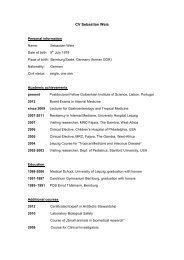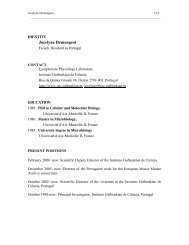organisation - the Instituto Gulbenkian de Ciência
organisation - the Instituto Gulbenkian de Ciência
organisation - the Instituto Gulbenkian de Ciência
- No tags were found...
You also want an ePaper? Increase the reach of your titles
YUMPU automatically turns print PDFs into web optimized ePapers that Google loves.
PLASTICITY CONSEQUENCES OF NATURALISTIC SPIKE TRAINS<br />
AT SINGLE SYNAPSES<br />
Naturally occurring patterns of activity are complex in structure and have an<br />
irregular distribution of action potentials. Thus far, synaptic plasticity at individual<br />
inputs has been assessed through <strong>de</strong>livery of regular patterns of activity.<br />
We aim to mimic <strong>the</strong> varied input patterns observed in vivo with glutamate<br />
uncaging at individual spines, in or<strong>de</strong>r to <strong>de</strong>termine what are <strong>the</strong> structural<br />
and plasticity correlates of <strong>the</strong>se forms of activity. We will <strong>de</strong>termine how such<br />
complex trains of activity interact across multiple synapses within a <strong>de</strong>ndritic<br />
branch. We will use this information to mo<strong>de</strong>l neuronal information processing<br />
in or<strong>de</strong>r to <strong>de</strong>velop an un<strong>de</strong>rstanding of <strong>the</strong> learning rules which govern<br />
synaptic weight changes.<br />
We have established a collaboration in or<strong>de</strong>r to obtain in vivo electrophysiological<br />
recordings from hippocampal CA3 neurons. Experiments in which electrophysiological<br />
recordings are coupled with 2-photon imaging in hippocampal<br />
organotypic slice cultures are un<strong>de</strong>rway in or<strong>de</strong>r to monitor <strong>the</strong> structural and<br />
plasticity correlates of spike timing <strong>de</strong>pen<strong>de</strong>nt plasticity. This form of plasticity<br />
<strong>de</strong>pends on <strong>the</strong> integration of events at single inputs, similarly to what is<br />
observed endogenously.<br />
AUTOMATIC DENDRITIC SPINE DETECTION AND ANALYSIS<br />
The combination of live 2-photon imaging and glutamate uncaging allows us<br />
to investigate how neuronal structure and function are correlated at <strong>the</strong> level<br />
of individual spines following synaptic activity. In addition to changes in <strong>the</strong><br />
volume of <strong>the</strong> spine head, many o<strong>the</strong>r changes in spine structure have been<br />
observed, for example, changes in <strong>the</strong> length of <strong>the</strong> spine neck. Such changes<br />
are difficult to quantify with existing methodologies, and <strong>the</strong>refore we aim to<br />
<strong>de</strong>velop automated data analysis tools for handling both <strong>the</strong> large data sets<br />
and <strong>the</strong> many variables to be analysed. We aim to achieve greater precision and<br />
flexibility in <strong>the</strong> quantification of structural changes, as well as to significantly<br />
enhance <strong>the</strong> efficacy of data analysis.<br />
Thus far, we have <strong>de</strong>veloped an automated, multi-level, region based segmentation<br />
method to <strong>de</strong>tect <strong>de</strong>ndritic spines from two-photon laser scanning microscopy<br />
images. I<strong>de</strong>ntified structures in two-photon images of <strong>de</strong>ndritic spines<br />
are used to train <strong>the</strong> segmentation algorithm. This is <strong>the</strong> first step towards a<br />
broa<strong>de</strong>r automated <strong>de</strong>ndritic spine <strong>de</strong>tection and analysis framework.<br />
IGC ANNUAL REPORT ‘11<br />
RESEARCH FELLOWS<br />
76






